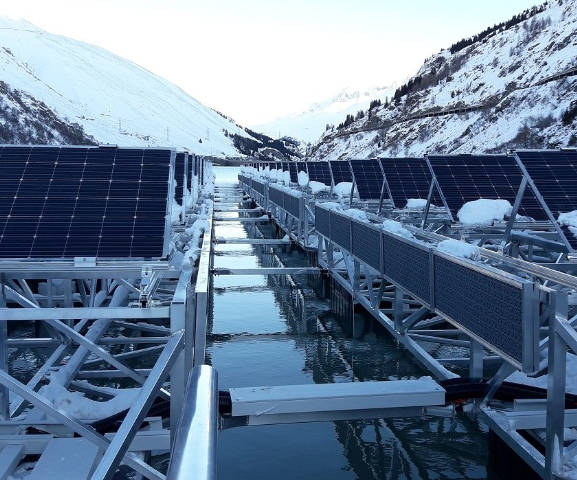
The innovative solar plant, situated 1810 meters above sea level on the artificial Lac des Toules in Switzerland, is predicted to produce more than 800,000 kWh of electricity per year and supply up to 220 homes in the region.
Located in the Swiss Alps, Lac des Toules is the latest in a global trend for installing floating Photovoltaic (PV) structures, which offer over 50 per cent more efficiency by using topography and the surrounding natural resources, as well as being driven by a need to source alternative locations for PV systems where onshore land is at a premium.
The plant in Lac des Toules is unique due it its high-altitude location and climatic conditions, along with the higher than average annual yields even in winter months when there are extreme minus temperatures and low solar irradiation.
Yields and efficiency levels are improved thanks to the use of bifacial modules and the ‘albedo effect’ whereby the lake and snow’s reflective light is captured by the PV system. This enables the PV plant to continue to operate and produce electricity even when there is snow coverage.
Guillaume Fuchs, project lead at Romande Energie said: “We have been working on this project since 2012, so collaborating closely with our partners has been critical. ABB’s capabilities to support above and below the line with a complete technology package – including its PVS-175 string inverters, a transformer station with a dry transformer, and switchgear for medium and low-voltage, advice and counsel – have been critical to achieving and realizing this unique installation.”
The 2240 sqm park consists of bifacial solar models on a carpet of 36 floats, which are secured to the bottom of the lake by weights, allowing it to rise and fall at the same time as the water. The location also means that the floating PV structure and technologies had to withstand winds of up to 120km/h, lake ice thickness of 60 cm, and the potential to support up to 50 cm of snow.
ABB’s solution offers several key benefits for installations like the Lac des Toules. PVS-175 inverters were selected to harness the energy yields thanks to the anti-corrosion coating which enables the inverters to be installed into both fresh and saltwater applications. The PVS-175 inverters are also suited to this type of application based on its capabilities to operate within extreme conditions and temperature variances from -25⁰C and up to 60⁰C.
At an altitude of 1810m, the arrays can harness strong light reflections on the snow, with the bifacial PV modules increasing efficiency of DC production by up to 30 per cent, even in winter months.
Not only will the PVS-175 perform under extreme weather conditions, but its multi-tracking facility also allows it to cope with seasonal and weather variances in water levels. Offering the highest number of MPPTs on the market – 12 in total – the floating PV benefits from greater capacity and maximum energy harvest without compromising versatility. It also offers flexibility in complex installations including floating structures, with its fuse and combiner free design allowing for ease of maintenance.
Giovanni Frassineti, who heads-up ABB’s Solar Business, comments: “We are proud to be enabling a more sustainable energy future with innovative and exciting projects such as this. As the energy markets shift at such a rapid pace, we need to look for alternative and unique opportunities to install solar through quicker installs, less infrastructure and improved return on investment.”